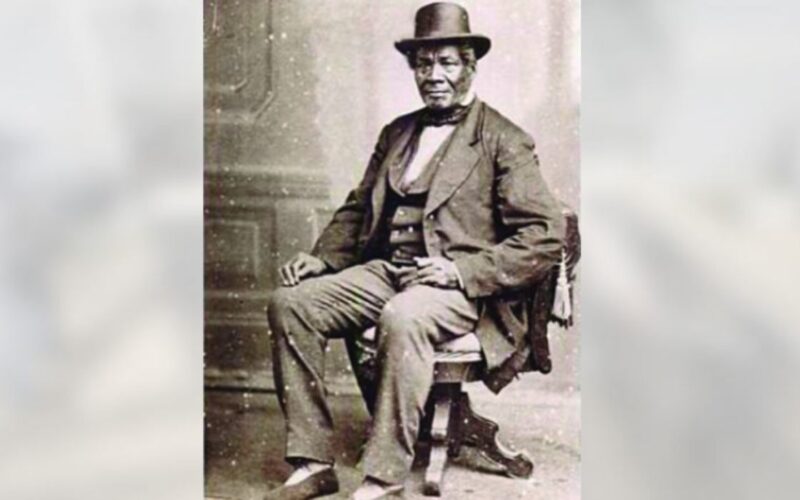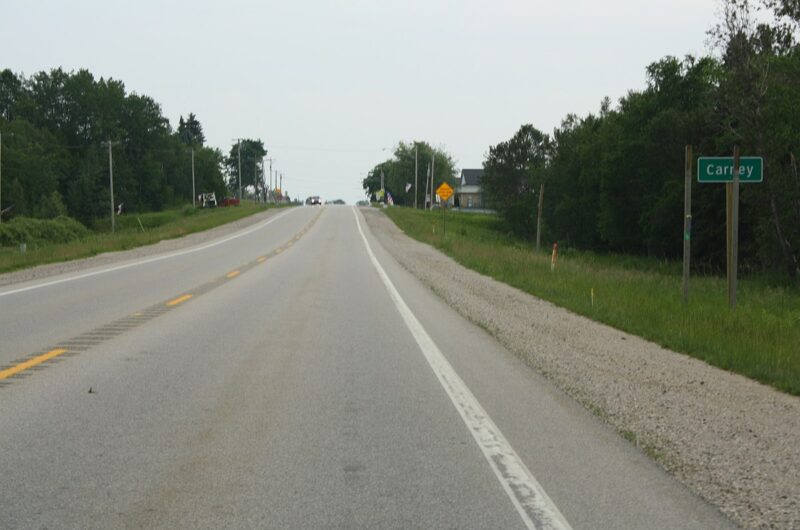Black Americans in Michigan’s Upper Peninsula – Part One

“Rural Voices” shares cultural, educational, economic and artistic views of people who have lived and thrived in the Upper Peninsula. Each of our authors in Rural Voices may be living here in the U.P. or living someplace around the globe, but the U.P. is an important part of who they are and what their beliefs and values are today. Rural Voices wants to share the voices of our neighbors and friends about life and experiences in the UP.
PART 1: LIFE TO 1840
Colonial Era, 1743-1796
The colonial period was dominated by the French to 1763 and then by the British until the American occupation in 1796. During this time, slavery as an institution was legal, and it was during this time that the first Black Americans were brought into the Upper Peninsula, and thus their history begins.
According to a royal decree made by King Louis XIV in May 1689, Black slaves were permitted in New France as French Canada was called at that time. On April 15, 1709, the intendant (economic minister) of New France, Jacques de Raudot, issued a decree in Québec which read, “all Indians and blacks who have been or shall hereafter be bought shall belong in full property to those who have acquired them or shall acquire them in quality of slaves.”
The first part of the decree permitted slavery and the latter portion legalized it. As the French entered the Upper Peninsula they carried these decrees with them.
As Black slavery expanded into other parts of colonial North America, it was challenged by Indian slavery in New France and especially in the Great Lakes country. Indians were readily available and less expensive to acquire than Black slaves and thus they were commonly traded and utilized.
Marcel Trudel, a noted French Canadian historian, has written that between 1689 and 1713, while there were numerous Indian slaves, called panis Canadian French, throughout the colony, there were only thirteen Black slaves.
Although Africans possibly accompanied the earliest seventeenth century French voyageurs, couriers de bois, and Jesuit missionaries into the Great Lakes country, the first documented evidence of Africans in the Upper Peninsula comes from the records of Ste. Anne Catholic church at Fort Michilimackinac.
Most of the citations from the baptismal, marriage and burial records indicate that there were numerous slaves in the settlement, but unfortunately the citations do not distinguish between Native American or Black slaves. However as in the St. Lawrence Valley, the Native slaves predominated.
The first African slave to be identified in the records was a little girl, Veronique, who was baptized on January 19, 1743. She was the daughter of Bon Coeur (Good-Hearted) and Marquerite, both slaves belonging to a voyageur, Sieur Boutin, who had been forced to winter at Michilimackinac on his way to the Illinois Country.
Other Africans were brought into the area and remained on a permanent basis. Jean Jarnet, Sieur de Verchères, the commandant of Fort Michilimackinac owned Charles. On January 6, 1744, after being given the proper religious instruction in the Catholic faith, Charles was baptized.
In 1762, Pierre du Jaunay, the Jesuit priest at Ste. Anne’s church owned Pierre, an African slave who was the property of the church. Under the French regime, slaves were used to carry out domestic chores or help with the many facets of the fur trade. One interesting fact which made French slavery differ from that of the British was the provision whereby slaves could be freed at any time. Most of these emancipated slaves remained part of the frontier communities.
When the French lost the French and Indian War they also surrendered their claim to North America. The British who took control continued the institution of slavery. According to the articles of capitulation signed on September 3, 1760:
The Blacks and panis [Indian slaves] of both sexes shall remain, in their quality of slaves, in the possession of the French and Canadians to whom they belong; they shall be at liberty to keep them in their service in the colony or to sell them; and they may also continue to bring them up in the Roman [Catholic] Religion.
During the British regime, the number of African slaves in Canada and at Fort St. Phillip de Michilimackinac and then Fort Mackinac increased. During the late 1770s, John Askin, a prominent merchant at the fort held three African slaves: Charles, Jupiter Wendell, and Pompey. They were all used in connection with the fur trade.
When Patrick Sinclair took command of Michilimackinac, he decreed that no person could hire nor harbor Indian or African slaves without the permission of their owners. It was a common practice to hire slaves out and then have the fee split between the slave and the owner.
Slaves provided a variety of services for the little community. The fur trade was the basic economic activity in the Upper Peninsula at that time and most of the slaves were engaged in aspects of this trade. Others were used on construction projects, especially when Fort Mackinac was constructed on Mackinac Island. In November 1779, two African lumbermen were rafting a load of timber across the Straits of Mackinac when a strong wind drove the raft out of control. They were eventually rescued by the crew of the Welcome near Bois Blanc Island. Africans also provided music for parties and dances in the community, which were popular during the long winters.
Besides the African slaves, there were a few free Blacks who visited and lived at Fort Mackinac. One of these was Jean-Baptiste-Point du Sable (1750-1818), who was a well-educated African trader and founder of Chicago. Another was Black Piter, who traded with the Native Americans in the Lower Peninsula.
There was also mention made of a small trading vessel manned by an all-Black crew which operated in the waters of Lake Michigan.
One of the more complete stories of Africans in the region during the colonial and early American periods revolves around the Bonga family of Mackinac Island. The story begins in St. Louis, several hundreds miles to the south.
During the American Revolution, George Rogers Clark and his Virginians entered the Illinois Country and met with Spanish allies in St. Louis. In the spring of 1778, a British expedition was organized at Fort Michilimackinac composed of Native Americans and fur traders and headed southward. Although the Spanish repelled the attack, Jean and Marie-Jeanette Bonga were among thirteen slaves carried away by the British.
The slaves were brought to Fort Michilimackinac and eventually Jean and two of the women were held by Captain Daniel Robertson. After a period of time, Robertson was instructed to return the slaves to the Spanish, but he did not want to send them back to the “Spanish rascals” as he referred to the enemy.
In 1780, Rosalie was born to Jean and Marie-Jeanette as was another daughter six years later. Freed by Commandant Robertson, the couple was married at Ste. Anne’s church on June 26, 1794 and made Mackinac Island their home. They were able to purchase a lot and opened the first hotel and tavern on the island and raised their growing family. They had four children: Etienne (b- 1776), Pierre (b- 1777), Rosalie Pruyn (b- 1780), and Charlotte L’Africain (b- 1786). Jean died on Mackinac Island in 1795 and is buried there.
Pierre Baptiste (1777-1831) was known in Ojibwe as Makadewiiyas or Black-Skinned. Living on Mackinac Island he was fluent in Ojibwe, French and English. He became a trapper and interpreter for the North New Company and for John Jacob Astor’s American Fur Company primarily along the Red River of the North and near Lake Superior. In 1820 when Henry Schoolcraft, explorer and later Indian agent visited the western Lake Superior country he discovered the grandchildren of the Bongas, at an Ojibwe camp located three miles above the mouth of the St. Louis at modern Duluth, Schoolcraft saw four Afro-Ojibwe children and met their mother. The grandchildren of Jean and Marie Jeanne Bonga moved across Lake Superior and were fur traders and interpreters for the US government in Minnesota where they played important roles.
Prior to 1796 an unnamed Black man and a voyageur landed at the future site of Menominee City and established a trading post. They predated Louis Chappieu’s trading post. All that is known is that the Menominee Indians were “irritated” by this Black man. They called a tumulus or mound on the banks of the Peshtigo River to the south, “N—er’s Hill.”
Early American Occupation, Post 1796
According to the terms of the Treaty of Paris in 1783, which ended the American War of independence, the western boundary of the United States was the Mississippi River. However, the British, wishing to exploit the fur-rich Great Lakes region, refused to evacuate the country.
After lengthy negotiations between American and British commissioners, Jay’s Treaty was ratified in 1794. One article called for the British to evacuate the region and a lesser known article directly affected the institution in the Great Lakes region: “All settlers and traders shall continue to enjoy unmolested, all their property of every kind. It shall be free to them to sell their houses, lands, or effects or to retain the property there at their own discretion.”
Although this treaty seemed to violate the Northwest Ordinance of 1787, which prohibited slavery northwest of the Ohio River, the original settlers in the region were allowed to retain their slaves since they were considered private property. Michigan’s territorial judge, Augustus B. Woodward in Detroit mandated that no new slaves could be introduced into the territory, and gradually those who remained would either be emancipated or die so that by 1837 when the new constitution was created there were only three slaves residing in the state.
Many of the descendants of Africans who had been brought into the region during the colonial era continued to reside there. The aforementioned Bonga family is a good example of this. According to the Federal census of 1810, there were 4,762 people in Michigan Territory, and this figure included 120 free Africans and twenty-four slaves.
In Michilimackinac County, which included the entire Upper Peninsula and all the territory westward to the Mississippi River, there were 615 people residing along with fifteen Africans and one slave. The census taken a decade later showed the white population increasing to 819 and there were only five free Blacks. During these years, prior to the discovery and exploitation of copper and iron in the Upper Peninsula, which stimulated a population boom, the number of Blacks remained small. In 1830 there were only five, and ten years later there were six.
Just a brief return to the War of 1812: During the war many Blacks served in the American army and navy and also joined the British. The story in the Upper Peninsula is incomplete about Black participation. However we know that during the Battle of Mackinac on August 4, 1814, in the midst of the raging battle, Major Andrew Holmes was killed, one of thirteen Americans to die that day.
It was known that the Native Americans who were a major force in the battle, would mutilate the bodies of dead Americans. An anonymous Blackman attendant, who was probably Holmes’ slave or freeman covered the body in the woods and thus it avoided mutilation. A few days later the body was recovered and given a proper burial.
During the decades prior to 1850 there is little information available concerning Blacks living in the Upper Peninsula. However, in 1825 at Sault Ste. Marie there was a contested election for a territorial representative and in the ensuing debate and investigation there were some interesting facts which were revealed.
The question to be answered was whether or not métis/mixed people could vote in these elections. The métis included issues from White-Indian unions and Black-Indian unions as well. To the whites at Sault Ste. Marie, these mixed bloods were considered second-class citizens.
One person in this class who had voted was described as one “who by the testimony appears to have descended from “Indian and Negro parents.” Once the debate was concluded it was decided that it was illegal for Native American and Blacks and métis to vote, so the fellow’s vote was not counted. This is an interesting and little known case of racial discrimination in a Federal election on the northern frontier.
The number of Blacks and the population in general did not dramatically increase until the mid-century with the opening of copper and iron mines in the mid-1840s. By 1850 there were fifty-two Blacks living throughout the Peninsula. There were thirty-seven in Mackinac County, eight living in Sault Ste. Marie, six in Ontonagon County, and one at Eagle Harbor.






Outstanding research on Blacks in the Upper Great Lakes! I look forward to part two.
Always interesting and thoughtfully presented material. Keep it up.
Good article Russ. Looking forward to part two.
Thanks, I appreciate the work and look forward to Part 2.
Thank you for the little known history of slaves/people of color in the UP. Very enlightening.
Excellent article, thank you!
Following because of my maternal family lines here☺️Wonderful to read and see some validity to the stories I have heard! Thank you!
Great article using the federal census data.
Looking forward to reading the coming article.
Very interesting read. Thanks. Looking forward to part 2
Jean and Marie Jeanette bonga would have been I do believe my sixth great grandparents. My mother’s maiden name is bonga. I just love when more information comes out we are not too savvy with research so when people do it and I find it I love to read it.